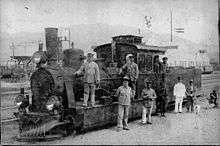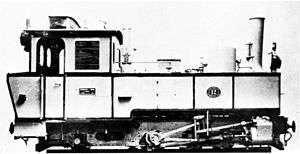South West African Class Ha
|
Class Ha works picture, c. 1904 | |||||||||||||||||||||||||||||||||||
| |||||||||||||||||||||||||||||||||||
| |||||||||||||||||||||||||||||||||||
| |||||||||||||||||||||||||||||||||||
| |||||||||||||||||||||||||||||||||||
The South West African Class Ha 0-6-2T of 1904 was a steam locomotive from the Deutsch-Südwest-Afrika era.
In 1904, the German administration in Deutsch-Südwest-Afrika acquired ten Class Ha tank locomotives with a 0-6-2 wheel arrangement, for lease to the Otavi Mining and Railway Company. Only one of these locomotives survived the First World War to be taken onto the roster of the South African Railways.[1][2][3]
Manufacturer
In 1903, ten 600 millimetres (23.62 inches) narrow gauge 0-6-2 tank steam locomotives were built for the German administration in Deutsch-Südwest-Afrika (DSWA) by Henschel and Son in Germany. When delivered in 1904, they were designated Class Ha.[1][4]
They were leased to the Otavi Mining and Railway Company, which operated a narrow gauge railway across the Namib Desert between Swakopmund and Tsumeb.[1]
Available sources are in conflict regarding the engine numbers of these locomotives. They were delivered by Henschel with numbers in the range from 11 to 20 on their cabside number plates, but were renumbered in the range from 21 to 30 by the railway, since the fifteen Jung locomotives were already numbered in the range from 1 to 15.[3][4][5][6]
Characteristics

The locomotives were similar to the earlier Jung locomotives in dimensions, but had larger boilers. They used Allan valve gear. Their "Ha" class designation identified the locomotive type as the first class to have been built for DSWA by Henschel.[1][3]
One of these locomotives, no. 27 and possibly more, were rebuilt in the Usakos Workshop for use on the Otavi Railway's fast passenger service, by removing the side-tanks and coal bunker and coupling it to a tender. Similar modifications were done on two of the Jung locomotives.[5][6][7][8]
Service
During the First World War, the former German colony came under South African administration and the railways in DSWA came under control of the Union Defence Force. Control of all railway operations in South West Africa (SWA) was passed on from the Military to the Director of Railways in Windhoek on 1 August 1915. On 1 April 1922, all the railway lines and rolling stock in the territory became part of the South African Railways (SAR).[1]
Only one of these locomotives, no. 22, survived the First World War into the SAR era. It retained its German Colonial Ha class designation and engine number in SAR service.[1]
Other locomotive types
At least two other locomotive types also served on the Otavi Railway, but information about them is sketchy. Even though they are reputed to have been built by Henschel, they do not appear in the Henschel works list.[4]
- In 1903, Henschel supplied a small side-tank engine with a four-wheeled tender. Its chimney and spark arrestor were of the inverted conical type. The wheel arrangement of the engine is not known, but the boiler pressure was set at 176 pounds per square inch (1,213 kilopascals) and the tractive effort at 75% of boiler pressure was 4,930 pounds-force (21.9 kilonewtons). The tender carried 2 long tons 10 hundredweight (2.5 tonnes) of coal and the engine's side tanks had a capacity of 1,210 imperial gallons (5,500 litres).[3]
- In the same year, Henschel supplied two small shunting engines with a 2-2-2 Patentee type wheel arrangement, numbered 28 and 29. It had two cylinders of 12 inches (305 millimetres) bore and 13 inches (330 millimetres) stroke and driving wheels of 33 7⁄8 inches (860 millimetres) diameter. The boiler pressure was set at 176 pounds per square inch (1,213 kilopascals) and the tractive effort at 75% of boiler pressure was 4,930 pounds-force (21.9 kilonewtons). The engine weight in working order was 18 long tons (18.29 tonnes).[3]
Since construction of the 600 millimetres (23.62 inches) narrow gauge Otavi Railway commenced in November 1903, the date in service of these two locomotive types suggests that they were acquired as construction engines.[2][9]
In 1914, Henschel shipped two 4-6-2 Pacific type locomotives to Swakopmund for the Otavi Railway, with works numbers 12829 and 12830. They were to have been numbered 31 and 32, but were lost at sea when their ship was sunk.[4]
References
- 1 2 3 4 5 6 Paxton, Leith; Bourne, David (1985). Locomotives of the South African Railways (1st ed.). Cape Town: Struik. p. 115. ISBN 0869772112.
- 1 2 Dulez, Jean A. (2012). Railways of Southern Africa 150 Years (Commemorating One Hundred and Fifty Years of Railways on the Sub-Continent - Complete Motive Power Classifications and Famous Trains - 1860-2011) (1st ed.). Garden View, Johannesburg, South Africa: Vidrail Productions. pp. 235, 379–382. ISBN 9 780620 512282.
- 1 2 3 4 5 Espitalier, T.J.; Day, W.A.J. (1947). The Locomotive in South Africa - A Brief History of Railway Development. Chapter VII - South African Railways (Continued). South African Railways and Harbours Magazine, October 1947. p. 859.
- 1 2 3 4 Henschel-Lieferliste (Henschel & Son works list), compiled by Dietmar Stresow
- 1 2 SAR-L Group. South African Railways Fans, Yahoo! Groups message no. 51280, 11 July 2016. (Accessed on 13 July 2016)
- 1 2 SAR-L Group. South African Railways Fans, Yahoo! Groups message no. 51283, 11 July 2016. (Accessed on 13 July 2016)
- ↑ Röhr, Gustav F. (1980). Die Feldspurbahnen Südwestafrikas 1000km auf 600mm Spur. Verlag und Büro für spezielle Verkehrsliteratur, Röhr Verlag. ISBN 3-88490-092-7
- ↑ Schroeter, Helmut; Ramaer, Roel (1993). Die Eisenbahnen in den einst Deutschen Schutzgebieten - Damals und Heute. Röhr Verlag GmbH, Krefeld, Germany. ISBN 3-88490-184-2
- ↑ Espitalier, T.J.; Day, W.A.J. (1947). The Locomotive in South Africa - A Brief History of Railway Development. Chapter VII - South African Railways (Continued). South West Africa. South African Railways and Harbours Magazine, August 1947. p. 667.
| Wikimedia Commons has media related to South African Class Ha (0-6-2). |
